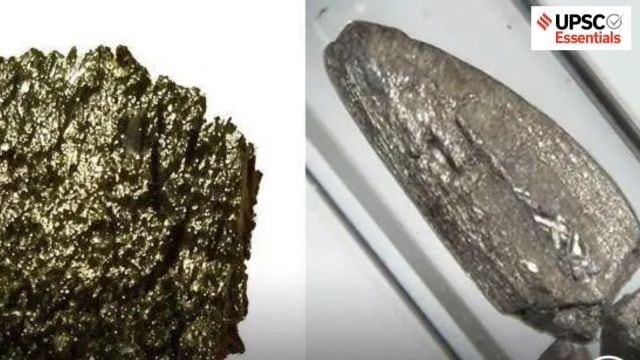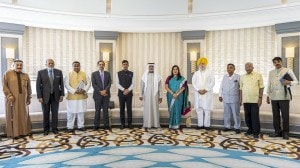What is India’s share in rare earth elements, the backbone of modern technologies?
Amid the ongoing trade war, China has suspended the export of rare earth elements (REEs), used in technologies ranging from smartphones, semiconductor fabrication and defence equipment. What is India’s stake in it?
New Delhi | Updated: May 5, 2025 20:23 IST
 Europium and Scandium (Source: Wikimedia Commons)
Europium and Scandium (Source: Wikimedia Commons)— Renuka
(The Indian Express has launched a new series of articles for UPSC aspirants written by seasoned writers and scholars on issues and concepts spanning History, Polity, International Relations, Art, Culture and Heritage, Environment, Geography, Science and Technology, and so on. Read and reflect with subject experts and boost your chance of cracking the much-coveted UPSC CSE. In the following article, Renuka, a Doctoral researcher working on environmental governance, explains rare earth elements and where India stands in terms of its global reserves and production.)
Amid the ongoing US-China trade war, Beijing has suspended exports of rare earth elements (REEs). These elements are critical for technologies ranging from smartphones, semiconductor fabrication and defence equipment.
But what are REEs? What are their geographical hotspots? Why are they called ‘seeds of technology’? What is India’s share in global REE reserves and production?
What are rare earth elements?
Rare Earth Elements (RREs), as defined by the International Union of Pure and Applied Chemistry (IUPAC) in 2005, are a group of 17 elements. These elements share similar properties such as high density and high conductivity. The 17 elements include 15 lanthanides plus scandium and yttrium (See table below).
The main sources of REEs are minerals such as bastnasite, loparite and monazite. Based on their atomic numbers, they are divided into two groups: the light group, also known as the Cerium group (light REE), and the heavy group, also known as the Yttrium group (heavy REE).
Despite the name – rare earth elements – these elements are not so rare. They are found in abundance in the Earth’s crust. However, they’re rarely found in concentrations that are economically viable for mining. Therefore, extracting and processing REEs is complex and expensive, requiring high-end techniques and specialised labour to isolate and purify them.
This has been the reason for the significant difference between global reserves and the actual amount of production of the REEs in different countries.
REEs, seeds of technology
Since their discovery in 1788, REEs have steadily become part of human life. The first commercial use was in an incandescent lamp mantle, which is composed of 99% thorium oxide and 1% cerium oxide. The first successful technical use was in Sunglasses (Neophan). For a very long time, REEs have also been used in scientific research to study the geological origin and formation of rocks.
However, in the last three decades, there has been a surge in the use of REEs in diverse sectors, driven by technological advancement. They are considered as ‘seeds of modern technology’. Right from their use in consumer electronics such as smartphones, computer screens, and televisions to their application in medical devices such as x-ray machines, MRI agents and cancer treatment applications, REEs are ubiquitous in our tech-driven lives.
REEs have also become essential for the defence sector as they are used in critical technologies such as lasers, avionics, radar, precision-guided munitions, aircraft engines. Moreover, due to their unique magnetic property, REEs are also used in green technologies like wind turbines, electric vehicles, and smart batteries. With the global shift towards clean energy, digitalisation, and advanced defence systems, the demand for REEs is poised to surge in the near future, reinforcing their status as the backbone of modern and emerging technologies.
Geographical hotspots
REEs are unevenly dispersed across the globe, with some specific regions being prominent hotspots. China has the largest share of the world’s reserve of RREs – 44 million metric tons, with production of 2,70,000 metric tons annually. According to the United States Geological Survey (2025), China accounted for over one-third of the world’s total REE production – 3,90,000 metric tons.
The extensive reserves in the Bayan Obo deposit in Inner Mongolia have enabled China to maintain its dominant position in the global supply of REEs since the 1990s. After China, Brazil has the largest reserves – 21 million metric tons.
The US holds 1.9 million metric tons of reserves. Due to its substantial reserves in California and the adoption of advanced extraction and refining technologies, the country emerged as the leading global producer of rare earth during the 1970s and early 1980s. However, this dominance collapsed in the 1990s due to environmental and political factors.
Between 1985 and 1995, China’s rare earth production surged from 8,500 to nearly 50,000 metric tonnes, boosting its global market share from 21% to 60%. It monopolised the global rare earth market by leveraging low production costs and advanced, efficient technology. It has strategically exploited this monopoly to exert pressure on countries like Japan in 2010 and recently on the US.
Where does India stand?
India has the third largest reserves of REEs, estimated at 6.9 million metric tons, largely in the states of Andhra Pradesh, Karnataka, Odisha, and Kerala. The monazite sands in Kerala are particularly rich in REEs. Monazite – a mineral mainly containing rare earths and thorium – is India’s principal source of rare earths.
As of March 2021, the estimated monazite resources in India stand at 12.73 million tonnes, according to the Indian Mineral Yearbook (2023), with Andhra Pradesh having the highest reserve of 3.78 million tons followed by other coastal states of Odisha, Tamil Nadu and Kerala. Most of the REEs available in India are light REEs such as Lanthanum, Cerium, Samarium, which already have large-scale availability. However, heavy REEs like Dysprosium, Terbium have supply constraints. China has a monopoly over the world market regarding heavy rare earth production.
Despite having large reserves of REEs, India produces less than one per cent of the total world share. There are numerous reasons behind this. The primary being the negligible involvement of the private sector in the mining of REEs. IREL (India) Ltd (the erstwhile Indian Rare Earths Limited or IREL) has been the primary entity involved in the mining and processing of Rare Earth. However, recently, the government has opened up REE exploration for private entities.
The next barrier to the low production of REEs is limited technological and infrastructural capability. Similarly, adverse environmental and health effects have been the major concerns. Monazite, the primary source of REEs in India, contains a high level of thorium, which is a radioactive material. Its extraction and processing are subject to strict regulatory control.
However, considering the significance of REEs, the government has taken several steps to enhance the domestic production of REEs. In 2023, the Mines and Minerals (Development and Regulation) Act, 1957, was amended, and Minerals of the “rare earths” group were classified as Critical Minerals.
In 2025, the government launched the National Critical Mineral mission with the objective of securing the critical mineral supply. India has also entered into agreements with countries such as Australia and the US to enhance partnerships on critical minerals.
Challenges and way forward
Despite their use in cleaner technology, the production of REEs is not so clean. It generates massive pollution, including dust, wastewater, and radioactive waste. It has a serious impact on the local environment and human health. Moreover, the intensifying global competition for REEs has raised concerns over resource nationalism and supply chain disruptions.
Considering this, it is crucial for the world to innovate sustainable mining practices and foster international partnerships. It also presents opportunities for India to accelerate its domestic production of REEs and to support its aspiration for energy security, technological innovation, and strategic autonomy in critical sectors. Practices like recycling electronic waste can provide an answer to issues like the demand-supply gap and reduce pressure on natural resources.
Seventeen REEs: 15 lanthanides plus scandium (Sc) and Yttrium (Y)
| 1. | Lanthanum (La) | 7. | Europium (Eu) | 13. | Thulium (Tm) |
| 2. | Cerium (Ce) | 8. | Gadolinium (Gd) | 14. | Ytterbium (Yb) |
| 3. | Praseodymium (Pr) | 9. | Terbium (Tb) | 15. | Lutetium (Lu) |
| 4. | Neodymium (Nd) | 10. | Dysprosium (Dy) | 16. | Scandium (Sc) |
| 5. | Promethium (Pm) | 11. | Holmium (Ho) | 17. | Yttrium (Y) |
| 6. | Samarium (Sm) | 12. | Erbium (Er) |
Post Read Questions
What are Rare Earth Elements? Why are rare elements ‘rare’ despite their abundance in the earth’s crust?
What are the major geographical hotspots of rare earth elements? Why are rare earths called the backbone of modern technologies?
What technological and infrastructural challenges does India face in scaling up REE production?
What policy steps has the Indian government taken to boost REE production? What is the significance of the National Critical Mineral Mission launched in 2025?
How can increasing REE production strengthen India’s role in clean energy, electronics, and defence supply chains?
(Renuka is a Doctoral researcher at Himachal Pradesh National law university, Shimla.)
Share your thoughts and ideas on UPSC Special articles with ashiya.parveen@indianexpress.com.
Subscribe to our UPSC newsletter and stay updated with the news cues from the past week.
Stay updated with the latest UPSC articles by joining our Telegram channel – IndianExpress UPSC Hub, and follow us on Instagram and X.
Must Read
Buzzing Now



May 23: Latest News
- 01
- 02
- 03
- 04
- 05























